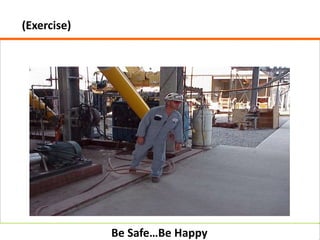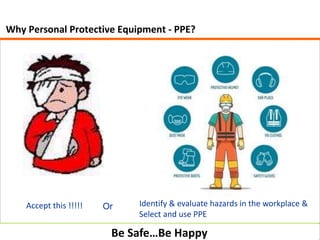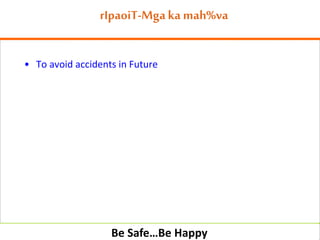Basic safety
- 1. Be Safe…Be Happy Training Program on Basic Safety
- 2. Be Safe…Be Happy • Introduction • Objective of the training • Basic Duties • Hazards • Near-miss • Accident • Site Specific Risk Assessment • Tool Box Talk • Causes of Accident • Reporting Table of Content
- 3. Be Safe…Be Happy Objectives • Starting and completing work safely • To Develop safe habits • To minimize damage and maximize safety There should not be a single incident of injury or injury to any of our employees and contractors
- 4. Be Safe…Be Happy • To ensure my own safety • To ensure the safety of co-workers at site • To ensure safety of General Public • To ensure the use of all PPE’s by me and my co-workers (all staff at site) • To co-operate with public / customers / other utilities and my contractor / company • To use work instruments / equipment's safely and in accordance with training and guidelines • To report any safety problems / hazards / Near miss on site Basic Duties (Exercise)
- 5. Be Safe…Be Happy Safety is a state of being protected from potential harm or something that has been designed to protect and prevent harm. “Freedom from danger, risk, or injury.” What is Safety ?
- 6. 6 Be Safe…Be Happy Hazard : Potential to cause an injury or Damage Risk : The risk is a combination of consequences and the possibility that the harm from particular hazard is realized. Near Miss : Any incident which could have resulted in injury to person or damage to plant or equipment or harm to environment, or any activity, which if allowed to continue, could have the potential to cause an incident. Accident : Unwanted and unplanned event, typically resulting in damage or injury. Hazard, Risk Nearmiss, Accidents and Control
- 7. 7 Be Safe…Be Happy • Workplace and Environment • Tools and Equipment • Poor Planning and designing • Poor Procedure Hazards Occurs from….
- 8. Be Safe…Be Happy CHEMICAL & DUST HAZARDS (cleaning products, pesticides, asbestos, etc.) BIOLOGICAL HAZARDS (mold, insects/pests, communicable diseases, etc.) ERGONOMIC HAZARDS (repetition, lifting, awkward postures, etc.) WORK ORGANIZATION HAZARDS Things that cause STRESS! SAFETY HAZARDS (slips, trips and falls, faulty equipment, etc.) PHYSICAL HAZARDS (noise, temperature extremes, radiation, etc.)
- 9. Be Safe…Be Happy H a z a r d N e a r m i s s A c c i d e n t Why reporting of hazard & near miss incident ? Unsafe Act / Unsafe Condition
- 10. 10 Be Safe…Be Happy 10 Hazard Near Miss Whew! Ouch! 5 T ? 5 T ? 5 T ? Accident Unsafe Act / Unsafe Condition
- 11. Be Safe…Be Happy Hazard / Nearmiss / Accident
- 12. Be Safe…Be Happy Hazard / Nearmiss / Accident
- 13. Be Safe…Be Happy
- 20. Be Safe…Be Happy Hazards Control
- 21. Be Safe…Be Happy Site Specific Risk Assessment 1. Look for the hazards Walk around the workplace and consider all the sources, situations, workplace tasks or environmental conditions which could lead to injury, damage, ill effect on health or negative impact on environment. 2. Exposure to Hazard How often are people likely to encounter this hazard.
- 22. Be Safe…Be Happy 3. Preventative Measures prevent access to the hazard, e.g. guarding, keeping doors locked. organize work to reduce exposure to the hazard 4. And Finally Implement and TRAIN, TRAIN, TRAIN staff in safe procedures. Continually monitor the hazards Site Specific Risk Assessment
- 23. Be Safe…Be Happy Tool Box Talk • Tool Box Talk place should be free from Danger • Give everyone a chance to talk • Everyone can see and hear you.
- 24. Be Safe…Be Happy Why Personal Protective Equipment - PPE? Identify & evaluate hazards in the workplace & Select and use PPE Accept this !!!!! Or
- 25. Be Safe…Be Happy sar kIsaUrxaa Head Protection
- 26. Be Safe…Be Happy Eye Protection
- 27. Be Safe…Be Happy paMvakI saUrxaa Foot Protection
- 28. Be Safe…Be Happy High voltage protection Dielectric Gloves Abrasion, cut , Puncture protection Chemical protection gloves High Heat Resistant Gloves Hand Protection
- 29. Be Safe…Be Happy Hearing Protection
- 30. Be Safe…Be Happy
- 31. Be Safe…Be Happy 31 Causes of Accident Causes of Accident Lack of Supervision Basic Cause Personal Factor Job Factor Sudden Cause Unsafe Act Unsafe Condition
- 32. Be Safe…Be Happy 32 Causes of Accident
- 33. Be Safe…Be Happy The unsafe behaviour that we see and don’t challenge today, becomes the accepted behaviour tomorrow
- 34. 34 Be Safe…Be Happy • Lack Of Safe Habits • Lack Of Proper Maintenance Of Equipment. • Electrical Faults (Short Circuits) • Lack Of Proper Storage Of Material. • Under Influence Of Substances (Alcohol / Drugs) • Illness • Lapse In Concentration • Short Cut Method • Under Time Pressure • Ignorance •Unaware of risks / hazards •Unaware of proper procedure •Embarrassed to ask •Follow others •Overconfidence •Lack of Knowledge •Stress Causes of Accident (Exercise)
- 35. 35 Be Safe…Be Happy 4% Unsafe Conditions 96% Unsafe Acts Causes of Accident What is the main cause of injuries Unsafe Acts or Unsafe Conditions?
- 36. 36 Be Safe…Be Happy Exercise Identify 5 scenarios of unsafe act and unsafe condition:
- 37. Be Safe…Be Happy Bird’s ‘Accident ratio triangle’
- 38. 38 Be Safe…Be Happy • Prevention is the Key to eliminate the chances of Accidents • Third Party Basic Safety Training to develop safety consciousness amongst all to follow safe habits. • Use IS marked electrical Equipment, Switches. Cables etc.. • Good Housekeeping to be improved. • To Follow Safety Rules • Use 3-Pin Plug. Never Use necked wire for connection. • Proper inspection and testing of Electrical Earthing. • Proper Storage of Material. • Floor should be clean all the time. • PPE use as per the hazards involve. • Never keep papers/ files etc on UPS Prevention Measures
- 39. Be Safe…Be Happy rIpaoiT-Mgaka mah%va • To avoid accidents in Future
- 40. 40 Must do Hazard / Near-miss Reporting Must do incident reporting To avoid accidents in Future
- 41. 41 Be Safe…Be Happy Thank You









































